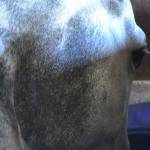Help Gastric Ulcers with Frequent Feedings

Many performance horses have ulcerations of the stomach that can hinder performance and well-being. Did you know that broodmares and lightly ridden horses are also at risk? According to veterinarians and researchers, one contributing factor to equine gastric ulcer syndrome, or EGUS, involves feeding management strategies, including lack of free feeding.
“Free feeding of performance horses or those maintained primarily in individual stalls is not a realistic option, compared to horses on pasture that will graze for 10-15 hours a day,” shared Kathleen Crandell, Ph.D., a nutritionist for Kentucky Equine Research.
For most performance horses, simply offering more hay will not provide sufficient energy, necessitating the addition of a concentrate to the diet. Typically, these grain meals are offered twice daily.
One viable alternative to this feeding dilemma, according to a recently published study*, involves using an automated feeder programmed to deliver 20 small grain meals spread over a 24-hour period.
The benefits of such a strategy were demonstrated after feeding Quarter Horses either the traditional way or with the automated feeder for 60 days. All horses were stalled individually for 60 days and maintained a moderate level of work during the study. Gastroscopies to grade EGUS were performed on days 0, 30, and 60, and all horses were offered hay at 2% body weight. Ulcers were recorded in the squamous or nonglandular portion of the stomach (equine squamous gastric disease, ESGD) or the glandular, acid-producing portion of the stomach (equine glandular gastric disease, EGGD).
Researchers found:
- There was no change in the number of squamous ulcers (EGSD) in the automated feeding group;
- An increase in EGSD was noted at both 30 and 60 days in the traditionally fed group; and
- Both groups had a lower incidence of EGGD, but the traditionally fed horses had a higher incidence at 30 days than the automated feeding group.
“These results suggest that multiple feedings a day, either manually or by a programmable feeder, could play an important role in decreasing the occurrence of gastric ulcers, or even minimize their development in the first place,” relayed Crandell.
Kentucky Equine Research offers RiteTrac for stomach health. RiteTrac contains specially formulated ingredients designed to support total digestive tract health. Australian horse owners should look for these research-proven products.
*Bass, L., E. Swain, H. Santos, et al. 2018. Effects of feeding frequency using a commercial automated feeding device on gastric ulceration in exercised Quarter Horses. Journal of Equine Veterinary Science. 64:96-100.








